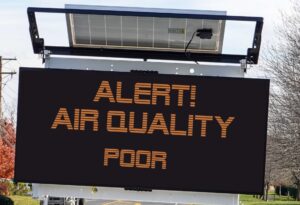Air Quality News explores the impact that volcanic eruptions are having on our atmosphere.
If the past 18 months haven’t already been enough to handle, late last month, La Palma, Spain experienced its first volcanic eruption in over 50 years. The eruption of the Cumbre Vieja volcano, which began in late September, has so far seen the forced evacuation of over 6,000 residents and the destruction of 1,300 homes and buildings.
The eruption itself isn’t particularly surprising, at any one time there are around 40 active volcanoes and for billions of years, geological processes like volcanic eruptions have controlled the atmosphere and the state of our climate. However, what is different about this specific eruption is its close proximity to the general population of La Palma.
When we see pictures of the Cumbre Vieja eruption or other eruptions of a similar magnitude, we see ash-covered skies and rivers of lava flooding the land.
However, according to Sævar Helgi Bragason, an expert in air quality and climate for the Icelandic Environment Agency: ‘Generally speaking, the lava itself is not really an issue, it’s the gas pollution emitted from the volcano that is by far the biggest safety concern for everyone in the area.’
Health impacts
Volcanoes emit a cocktail of chemicals, but one pollutant that is a major cause for concern is sulphur dioxide (SO2). Like with other more commonly known pollutants, SO2 is associated with a wide range of health impacts, from respiratory issues such as asthma and bronchitis to cardiovascular and lung disease.
Dr Anja Schmidt, an expert in the impact that volcanic eruptions have on air quality at the University of Cambridge analysed the air pollution impact of the 2014 Bárðarbunga eruption in Iceland and found that the volcano emitted 12,000 tonnes of SO2 per day, this is three times more than all European industries combined.
In another study led by Dr Schmidt in collaboration with the University of Iceland, the researchers found that at the time of the eruption, incidents of respiratory disease rose by a quarter and the incidence of asthma medication dispensing increased by a fifth.
‘This is the first study to convincingly show that there is a direct link between respiratory health and the presence of volcanic pollution,’ Dr Schmidt tells Air Quality News.
The Cumbre Vieja eruption in La Palma is still ongoing and the complete air pollution picture is yet to be fully understood, however recent satellite images published by the European Space Agency revealed that SO2 emissions from the eruption were moving over the Atlantic Ocean towards Central America.
As the molten lava from the Cumbre Vieja eruption has flowed into the ocean, Spanish authorities have warned of the potential health impacts from exposure to ‘laze’ pollution.
Laze occurs when hot molten lava comes into contact with ocean water, forcing the water to evaporate and creating magnesium salts that mix with the steam.
According to the U.S Centers for Disease Control and Prevention (CDC), breathing in laze pollution may damage the lungs. This damage is caused by the dangerously corrosive hydrogen chloride, which is a product of the laze. Hydrogen chloride creates an accumulation of fluid in the lungs, referred to as pulmonary edema, which results in fatigue, chest pain, and coughing.
In severe cases, laze can be fatal to both humans and marine life. The heat from the volcanic lava can boil fish in the ocean and leave them floating on the surface of the water.
Preparation
While there is nothing that can be done to reduce or prevent the pollution from volcanic activity, a lot can be done to prepare in order to minimise the health impacts when a volcanic eruption inevitably occurs.
As a country known for its volcanic activity, the Icelandic Government now has specific devices in place to measure volcanic pollution, this information is then sent to a live feed which warns the general public if any spikes in air pollution do occur.
However, it is not just the countries that are home to these volcanoes that need to prepare.
During the 2014 eruption, researchers found that pollutants were being transported more than 3,000 kilometres from Iceland.
Following on from this, Dr Schmidt has been working with the UK Government to update the National Risk Register.
This means that similar to acts of terrorism, heatwaves or pandemics, the UK now has a plan in place to deal with the potential pollution impact from volcanic eruptions overseas.
As part of this preparation, the Met Office now has a UK-wide light detection and ranging (LIDAR) network, which uses satellite information to provide data on ash-cloud and volcanic pollution.
‘Countries are well aware of the potential impacts of volcanic pollution on human health and so there is no excuse not to prepare,’ says Dr Shmit.
‘I think governments are doing as good a job as they can at the moment to communicate with the public, but really it’s about education, it’s about telling the public about the impact that air pollution can have on their health and informing them of the precautionary measures that they need to take.’
However, Sævar expressed concern that while the governments do know the extent of the health impacts, the public is still largely unaware.
‘I think that people tend to look away or turn a blind eye,’ says Sævar,
‘The information is out there, but because the pollution normally only lasts a day or two the public don’t think they are in grave danger and so they choose not to think about it. But what they don’t know is that just because this pollution isn’t causing them any serious harm right now it could still lead to health complications further down the line.’
Climate impacts
Alongside the pollutants that are emitted from volcanic eruptions, volcanoes are also a source of carbon dioxide (CO2) emissions.
According to a study published in 2019, volcanic activity is estimated to be responsible for around 280 – 360 million tonnes of CO2 per year.
This might sound like a lot, but to put this into perspective humans emit around 36 billion tonnes of CO2 per year.
According to Sævar, humans take around three days to release the same amount of CO2 as every volcano on earth.
‘An eruption in Iceland earlier this year emitted about 10,000 tonnes of CO2 per day,’ he explains.
‘This eruption would need to continue at this level for two to three years just to equal the amount of CO2 released by humans in one year.’
Volcanoes can also actually help to mitigate the impacts of industrial emissions by having a cooling impact on the planet.
‘If the ash from the volcano is blown into the surface of the stratosphere it can act as a mirror, radiating the sun’s rays back into space,’ explains Sævar.
The most famous example of this is with the eruption of the Pinatubo volcano in the Philippines in 1991. According to some estimates, the eruption decreased world temperatures by about 1°C over the two years following the eruption.
Looking forward
Although there is no doubt that volcanic eruptions are a serious source of air pollution, Sævar has been quick to point out that any spike is usually very short-lived.
‘Fortunately for us, volcanic eruptions are usually not very long lasting, they usually erupt for only a few weeks or months. So in the end they do stop emitting all these pollutants,’ he tells Air Quality News.
‘Volcanic eruptions are part of nature, we have no control over them, but what we do have control over is industrial pollution and so our focus must be on strengthening regulation to reduce the pollution and emissions from man-made sources.’
This article first appeared in the November Air Quality News Magazine, click here to view.

















Leave a Reply